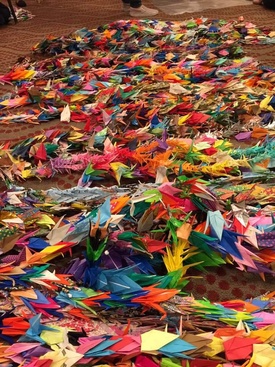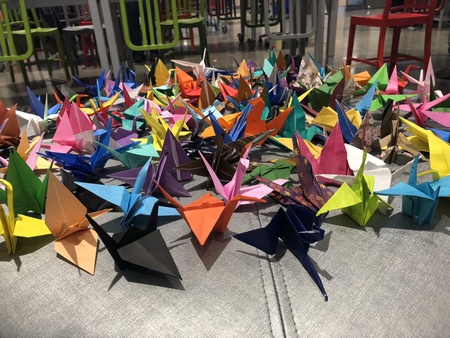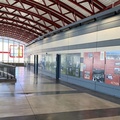Twenty thousand, and more.

As I type, twenty-five thousand origami cranes are being gathered in Austin, Texas. They’re going to be coming from approximately 150 locations all over: cranes have been shipped from California, New York, Oregon, Pennsylvania, Missouri. Some are coming from overseas. And at least 12,000 are coming from Washington State, where I am writing.
In late March 2019, close to a hundred Japanese American activists will also be traveling from all over the United States. In conjunction with the Crystal City Pilgrimage committee, they will travel with the cranes and hang them at the Family Detention Center in Dilley, Texas.
I am part of an informal network of Japanese American activists around the country. Many of us met through community events or through organizing for other causes. Many of us organized to stop the sale of Japanese American artifacts made in camp to the Rago Auction House a few years ago; many of us also organized recently to try to stop the sale of Tule Lake land for an airport in California, where many of our relatives were unconstitutionally imprisoned during World War II.
I have folded thousands of cranes before, but I think this occasion is especially poignant and significant. Crane folding is an act of care, of good wishes, of human touch. As a mother, it is heartbreaking for me to think about children being denied human touch due to separation from their parents—not even siblings are allowed to touch each other— but also the evil inverse of that human touch: of being physically and sexually abused. In the Japanese American community, we know that the trauma of family separation creates trauma which lasts for generations.
There are stories behind the cranes (and the people) traveling to Crystal City. This is not just an action of “thoughts and prayers.” This is an act of protest, an act of solidarity. Many of the cranes traveling will be precious: birds that have been kept in boxes, basements, and attics for years. I have written about Japanese Americans hoarding things for decades, due to intergenerational trauma—and so I want to mark these traveling cranes as a form of release. And once again, it is a moment of the powerful spirit of kodomo no tame ni: for the sake of the children, for our own children, and for those in detention now. I want to acknowledge it as a moment of healing for the Japanese American community.
Thousands of cranes together will be a powerful, beautiful testament to the power of collective action. These are some of the stories behind Washington State’s 12,000 cranes.
* * * * *
Two years ago, I worked with historians and members of the Japanese American community from Vashon Island to document the island’s long but little-known Japanese American agricultural history. I wrote to them to ask if they would be willing to contribute cranes. They responded almost immediately. A “small but mighty” group of crane folders participated in an origami session at the Mukai House. This farmstead house, now close to 100 years old, still stands with its accompanying Japanese rock garden. The Friends of Mukai, a nonprofit organization, hold several open houses at the house each year and they are using it as a way to share and preserve the little-known Japanese American history and culture on Vashon Island.
Vashon Island sent 300 cranes.
* * * * *
Up in Seattle, my good friend and Yonsei scholar Vince Schleitwiler participated in a crane folding session with Densho. I was so happy to see his young daughter folding cranes as well.
Later he told me that several generations of his family participated from at least four different states. “To me, solidarity for those who are targeted and scapegoated is what it means to be Japanese American in this millennium,” he wrote to me. “Incarceration isn't over because the meaning of camp, the consequences of that history, are still being decided, and we're still fighting the same fight.”
The Densho session yielded several hundred cranes.
* * * * *
Elsewhere in Seattle, at the Japanese Cultural and Community Center, Bill Tashima and Stan Shikuma organized a crane-folding session through Seattle JACL and Puyallup Valley JACL.
Local teens Max and Kai Vu participated at this event. Their great-grandparents were incarcerated at Minidoka. “It is important for our country to not repeat history,” wrote Kai, “and by helping to fold over 10,000 cranes, we can demonstrate our support and remind people of that message “We, the next generation, need to be able to advocate for human equality as the next leaders of the new world,” added Max.
“We didn’t know what to expect,” Bill Tashima wrote to me in an email. “[But] we were overwhelmed and so proud that our community would respond so strongly. He added: “I was really touched by the children who folded cranes…[their ages] probably matched the ages of the separated children in the facility. I can only hope that the children inside the Dilley facility will see the cranes and know that they are not alone. I could only imagine the impact such an event would have had 75 years ago for our Issei and Nisei if people placed tsuru on the barbed wire of the incarceration camps. “
The JACL event collected close to 11,000 cranes.
* * * * *
People folded cranes, but also began to bring their folded cranes from family occasions: birthdays, weddings, anniversaries, memorials.
Bill Tashima added that “Eugene Tagawa dropped off the tsurumai from Mari and Alysa Sugiyama who donated the beautiful tsurumai from their father, Al Sugiyama’s memorial. Eugene said they both thought their father would have wanted to share these cranes for this meaningful event.”
Tom Ikeda, director of Densho, sent cranes from his family’s crane folding session, but also sent a thousand silver cranes from his Nisei parents’ silver wedding anniversary.
Back in Tacoma, my friend Cathy Tashiro told me that she had sent close to 600 red cranes that her relatives had folded for her wedding, several decades ago. “I hung on to them all these years through many moves, she wrote, “and I’m SO happy to donate them to this worthy cause.”
These contributions: close to 2500 cranes.
* * * * *
At Tacoma’s SAMI (Science and Math Institute), I taught close to 80 students how to fold cranes, and asked them to consider mass incarceration from the past and present in our community. We talked about “Camp Harmony” at the state fairgrounds at nearby Puyallup, and the Northwest Detention Center on Tacoma’s tideflats.
“I hadn’t really thought about the parallels between the Japanese American incarceration and the families at the border,” said one young man at the high school.
It felt different when the students placed their cranes together, rather than just a few in the center of a table.
* * * * *
I cannot travel to Texas, but I sent close to 800 from me and members of my community in Tacoma. Friends in my book club and their children’s fencing club added their folding efforts as well. I folded them out of love, out of protest, and in solidarity with those families being separated as well as my Japanese American activist friends who are traveling to Texas to bear witness and protest with their bodies. Close to 800 Japanese Americans were forcibly evacuated from Tacoma in 1942, and so I feel a jolt of recognition with this number.
* * * * *
I am sending solidarity with people like my friend James Arima, a Nikkei and Crystal City survivor with roots in Seattle and Bellevue and Crystal City. In an e-mail, James explained his reasons for returning to Crystal City:
“Reports of children being separated from their fathers and/or mothers have been increasingly bothering me. Some of them will never be reunited. But what am I capable of doing besides voting?… Expressions of dismay to friends in person and postings on social media did not provide the internal comfort I yearn for.
“The official name used on the ICE website is the South Texas Family Residential Center. Too much like the USA WWII concentration camps being referred to as assembly centers and relocation camps.
“My Father was forcibly separated for almost three years from my Mother and five older siblings. I am the product of their reunion in Crystal City. After my birth, my Father was issued deportation orders. Fortunately that order was rescinded and our Family regained our physical freedom in 1946. But parts of our emotional selves remain in captivity even today.
“I attended an immigration rally in Seattle inspite of the cold and threatening weather. Some signs that were distributed will accompany me to the Crystal City Pilgrimage protest in Dilley.
“More than forty years ago I had traveled to Crystal City. A tourist t-shirt bearing “I have been to Nowhere” was not available as there were no other tourists. The city hall staff could only point me in the direction of the former camp site. They could not provide more information. It appeared to be simply a barren area of weeds. There were no plaques then.
“Later a fortune teller told me that I had been born in a very bad place and that I should never go back. But in a few days I will return. Hoping to heal a portion of my emotional self.”
© 2019 Tamiko Nimura






